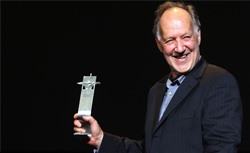Cave of Forgotten Dreams
If you are a member of the human race, you should see this movie.
After you've seen Cave of Forgotten Dreams, check out our Spoiler Special discussion:
You can also download the program here, or you can subscribe to the Spoiler Special podcast feed via iTunes or directly with our RSS feed.
Also in Slate, Daniel Engber assesses the use of 3-D in Cave of Forgotten Dreams.
Last year, the German filmmaker Werner Herzog petitioned the French government for an unprecedented chance to film inside the Chauvet cave of southeastern France. (The image of the sometimes pugnacious director pressing his case at the French Ministry of Culture begs for a film all its own.) Chauvet, the most recently discovered and by far the oldest of the great Paleolithic cave-painting sites of Western Europe, has been visited only by a small group of scholars since it was found by three spelunkers on a hike in 1994. Like all the sites from this period—perhaps more than most, since a long-ago landslide sealed off this cave from the outside world for at least 20,000 years—the Chauvet cave is a fragile ecosystem that could easily be destroyed by untrammeled human access.
Miraculously, Herzog was granted permission to film, and for a six-day period he and a skeleton crew of three descended into the cave with very limited equipment—three cold light panels and a custom-built 3D camera rig—to give the rest of the world what may be the closest look we will ever get at some of the world's earliest works of art. The resulting movie, Cave of Forgotten Dreams(IFC Films) is itself a work of art—one that partakes, across imponderable millennia of remove, in some of the uncanny beauty and mystery of these caves. If you're interested in the history of the human race—if you're a member of the human race—you owe it to yourself to see this movie.
Herzog's technique is the antithesis of the traditional art documentary (static shots of the work with explanatory voiceovers from experts). His camera is constantly roving over the surface of the cave walls—a surface that's undulating, pocked, scratched in places by the claws of the now-extinct cave bears that once inhabited the place. And though there are ample chunks of that irreplaceable Herzogian voiceover, there are also stretches of near-silence in which we hear nothing but the dripping of water from rock formations or the (amplified) sound of the cameraman's heartbeat. Sometimes, there's music—a strange, beautiful score by cellist Ernst Reijseger that sounds like something Bach might have composed if he'd lived in the Stone Age.
As for the art, well, the whole reason you need to see this movie is that it's hard to get across a sense of these paintings' brilliance in language—or in photographs, for that matter. Even the best book of reproductions—like Cave Art, by Chauvet research team leader Jean Clottes, who appears several times in the film—can't convey a sense of the cave's contours, or the spatial relations between one painting and the next. And no book I've seen has paid attention to how the nonpainted features of the cave, like the stalagmites and stalactites that have appeared in the 30,000+ years since the cave was last painted, enrich its weird otherworldly beauty. For the first time seeing this film, I realized that painted caves, when you're in them, feel like not museums but chapels. Large-scale drawings like the Panel of the Lions move across entire walls like Renaissance frescoes, telling stories of animal hunts or mythical, sometimes sexual encounters between man and beast. (Some images, like this rhinoceros whose horn seems to have been depicted in motion, prefigure cinema, as Herzog observes in voiceover.)
Of course, we will never know exactly what purpose the painted caves served for the Aurignacian cultures who made them, and some of the speculative theories Herzog floats (Were sites like Chauvet really "the origin of the modern human soul"? Was the cave bear skull placed on a flat rock in the cave meant to serve as part of some sacred ceremony?) might get him in trouble with contemporary archeologists less focused on swooning over Chauvet's awesomeness than on measuring and documenting its every grain of sand. But this is why Herzog makes such good company inside the cave. He's not a docent, a professor, or a critic: He's a lover, a looker, and a listener. Herzog draws us in with his profound reverence for the place—a reverence that doesn't come off as scholarly and pious, but as blazingly direct and passionate.
Watching Cave of Forgotten Dreams is a seductive, vertiginous experience. The dimly lit walls, the stalactites and stalagmites sparkling with crystal formations, the weird music, the impossible-to-conceive durations of geological time—all lend the two hours in the theater the quality of a drug trip. But when the camera does venture above ground, the film can be down-to-earth and bracingly funny. As with his last documentary, Encounters at the End of the World, Herzog has an eye for—and a visible affection toward—the oddballs and obsessives he meets along the way, researchers who devote their lives to understanding one small part of the cave's mysteries. One handsome young scientist mentions that his last job was as a circus performer. An older researcher appears clad in a reindeer-skin tunic to play Herzog a song on a flute he carved for himself from the radius of a vulture. What song the man plays I'll leave as one of this movie's many small surprises, including a bizarrely poetic coda, about which all you need to know is that it involves mutant albino crocodiles.

